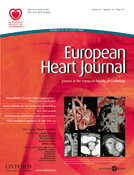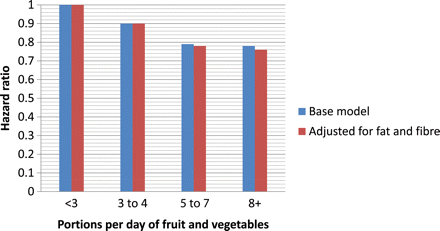-
PDF
- Split View
-
Views
-
Cite
Cite
Michael Marmot, Fruit and vegetable intake reduces risk of fatal coronary heart disease, European Heart Journal, Volume 32, Issue 10, May 2011, Pages 1182–1183, https://doi.org/10.1093/eurheartj/ehq506
Close - Share Icon Share
This editorial refers to ‘Fruit and vegetable intake and mortality from ischaemic heart disease: results from the European Prospective Investigation into Cancer and Nutrition (EPIC)-Heart study’†, by F.L. Crowe et al., on page 1235
How far we have come! A generation ago, researchers ‘knew’ that diet was linked to risk of cardiovascular disease—they just could not show it directly in their studies. Longitudinal studies, measuring dietary intake of individuals, and linking that intake to subsequent risk of coronary heart disease (CHD), were unconvincing. Actually, they were convincing to the critics who concluded that the diet–heart emperor had no clothes;1 and frustrating to others who had good animal experimental, and other, evidence that diet was indeed linked to heart disease risk.2
It is of course possible that the failure to show a clear link between diet and cardiovascular risk was that none existed. Subsequent evidence suggests that is not the case.3 More probably, earlier studies suffered from the notorious difficulties in accurate assessment of diet in population studies; and they were too small. Much of the previous work related to dietary fat. There was little doubt that plasma cholesterol predicted CHD, and that manipulations of the type and amount of dietary fat influenced plasma cholesterol. The ability to lower plasma cholesterol through statins, and thereby reduce the incidence of CHD, removed doubt about many of the causal links between plasma cholesterol and CHD.4
But what of other features of diet? Fruit and vegetables have been the province of cancer prevention. The advice to eat five a day was to reduce cancer risk. Interestingly, a comprehensive international review of diet and cancer did not grade the evidence linking fruit and vegetable to cancer as ‘convincing’ for any cancer site.5 It did, however, find the evidence that fruit and vegetable consumption was protective to be ‘probable’ for cancers of the mouth, pharynx, oesophagus, stomach, and lung. Food containing lycopene—tomatoes—was protective of prostate cancer. Obesity was convincingly related to several cancers, but the World Cancer Research Fund panel did not conclude that fruit and vegetables had a specific protective effect on weight gain. Although, if it turns out that higher fruit and vegetable consumption goes along with lower intake of energy dense or fast foods, there could be an indirect protective effect on obesity.
The potential protective effect of fruit and vegetables on cardiovascular disease is therefore of great importance if advice on healthy eating is to be based on sound evidence. The study by Crowe and colleagues is a key contributor to that evidence.6 The EPIC (European Prospective Investigation into Cancer and Nutrition) group of cohorts was set up to have the power to detect relationships between diet and cancer, if such exist, and has made important contributions to that literature. From fairly early on in the planning of these cancer studies, the decision was also taken to examine cardiovascular disease outcomes. The numbers and logistics are truly impressive. Ten cohorts of individuals were enrolled into longitudinal studies—diet and other characteristics being assessed at baseline. The study of Crowe et al. presents data on 313 074 men and women from eight European cohorts followed for an average of 8.4 years.
EPIC dealt with both problems of the earlier studies. It is large; two of the cohorts, France and Norway, were excluded from the present analysis because the number of cardiovascular deaths was too small. EPIC also put great effort into refining dietary methodology. It utilized a dietary questionnaire, which was calibrated against a dietary recall method, common to all centres.
The main results are summarized in Figure 1. Eight portions (a portion is 80 g) a day of fruit and vegetables were associated with a 22% reduction in CHD mortality compared with <3 portions. Of course, a central issue with dietary studies is that people do not eat single foods. They have patterns of consumption; more of one type of food is likely to be associated with less of another. Controlling for such linkages is not easy. In the study of Crowe et al.6 adjustment for dietary fat and fibre made little difference to the results. Further, there may be confounding: people who eat more fruit and vegetables may differ in other ways from those who eat less. All the analyses in Figure 1 adjusted for smoking, alcohol intake, body mass index, physical activity, marital status, education, employment, hypertension, angina, diabetes, and total energy intake.
Risk (hazard ratio) of fatal coronary heart disease associated with fruit and vegetable consumption . The base model adjusts for covariates; the fat/fibre model adjusts further for dietary intake of fat and fibre.
With an odds ratio of 0.78, one always worries about residual confounding. The consistency of these results with those from other studies makes it more likely that the associations are causal. Certainly that is the conclusion from the investigators conducting the Nurses' Health Study and Health Professionals Follow up Study,7 and a subsequent meta-analysis.8
Commonly, one hears the clinical line of argument: if fruit and vegetables are protective why not isolate the protective nutrient, put it in a pill, and thereby dispense with worry about diet. That approach has not proved useful. Trials of antioxidant vitamins have not led to reductions in either cancer or cardiovascular disease. That may be because antioxidant vitamins were not the crucial protective components; or it is the foods and, indeed, dietary patterns that are important, not specific micronutrients.
I commented above that an odds ratio of 0.78 made conclusions about causation somewhat shaky. Such an odds ratio is, however, of huge practical importance. Cardiovascular disease is the most common cause of death. A reduction of 22% is huge. But … this reduction in mortality comes with consumption of eight portions a day, or 640 g. Such a high consumption was found in only 18% of the men and women in these eight cohorts. There would need to be big shift in dietary patterns to achieve this healthy consumption of eight portions a day. It is worth trying to move in that direction. Reductions in cancers of several sites, in blood pressure and stroke, would add to this reduction in fatal CHD. Moving to a diet that emphasizes fruit and vegetables is of great importance to public health.
Conflict of interest: none declared.
References
Author notes
doi:10.1093/eurheartj/ehq465
The opinions expressed in this article are not necessarily those of the Editors of the European Heart Journal or of the European Society of Cardiology.




